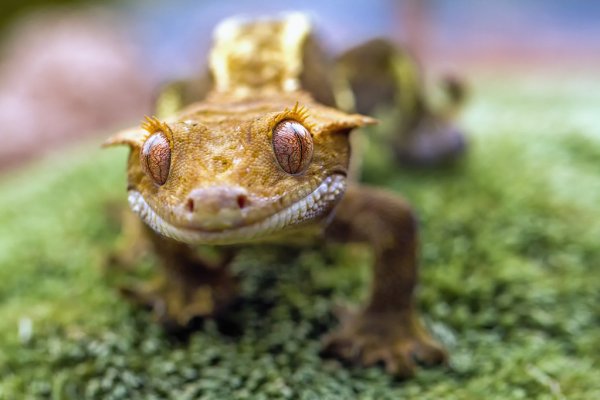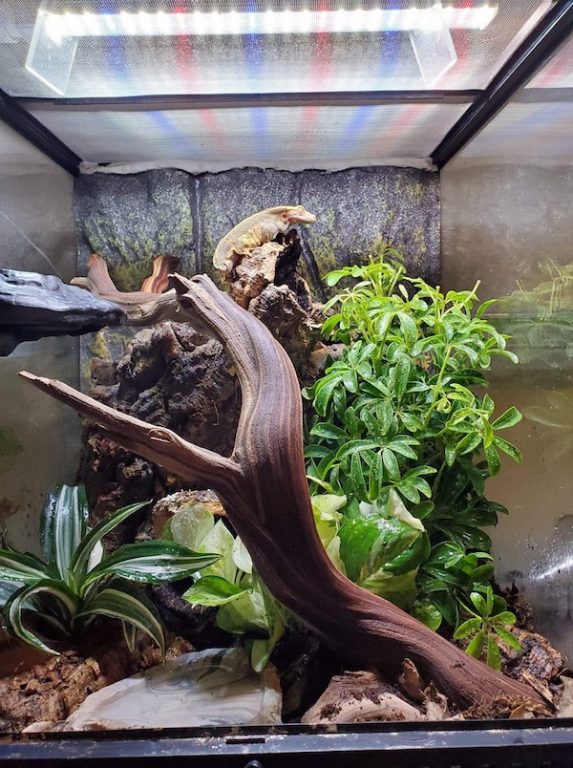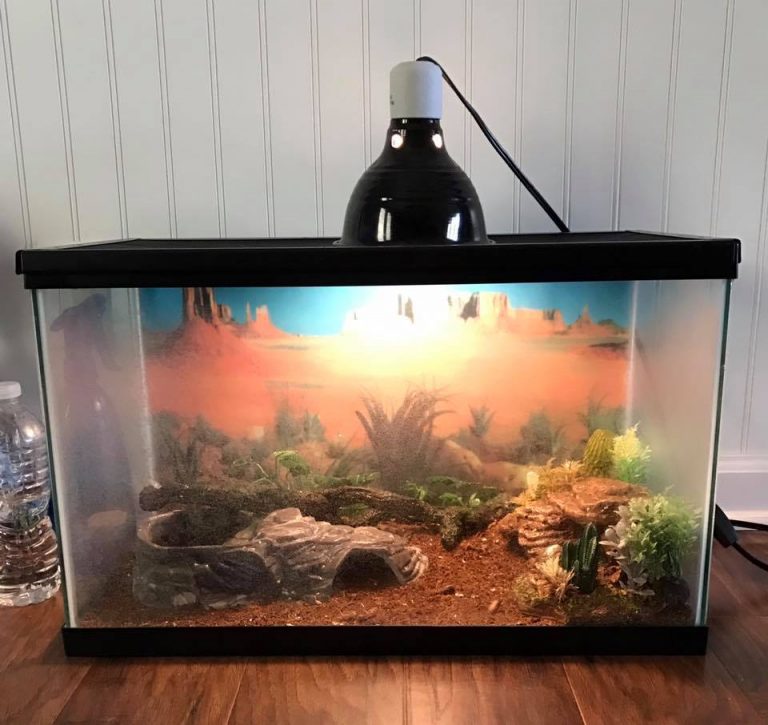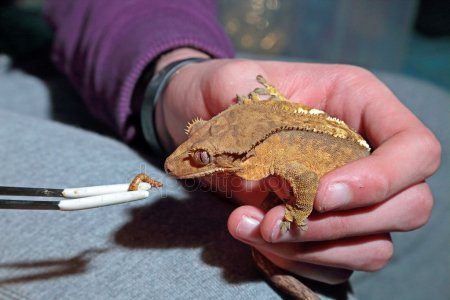Crested gecko supplies are list of items you will need to take care of your adorable reptile creature. Geckos are very easy reptiles to maintain for beginners and also a lot of fun for old timers as well.
However, it is very important to take note of required crested gecko supplies even before you purchase your lovely pet – that way, you are sure of taking good care of your beardie.
There are different types of crested gecko supplies you will need to have to give the required care to your cute pet, because the health and all round well-being of your beardie can not be overstated. This article will provide the much needed guide through the list of most essential crested gecko supplies for your pet.
Types of Crested gecko supplies include feeding supplies, cleaning supplies, housing supplies, and furnishing supplies. The above mentioned are unavoidable necessities to give your cuties the much needed care they deserve.
Housing Crested Gecko Supplies
Considering the fact that the beardie’s natural habitation are in trees in the wild, it will be wise to provide a home for them that is similar to what is obtainable in the wild. Your cage should include lots of hide outs, providing secured housing for your pet, and this can be purchased from different crested gecko supplies.
You could get a natural terrarium or even a Kritter Cage for beardie depending on your budget; fact remains that crested gecko supplies can be acquired inexpensively to fit your income. However, your choice of cage should most necessarily include hiding places for your reptile to hang-out and feel secured.
Check out our review: Best crested gecko tanks
Crested Gecko Substrates
 Crested gecko substrates are always controversial when discussed between crested gecko keepers as there are many options available to use ranging from terrarium soil mix, to paper towels or even the artificial reptile carpet.
Crested gecko substrates are always controversial when discussed between crested gecko keepers as there are many options available to use ranging from terrarium soil mix, to paper towels or even the artificial reptile carpet.It is important however to pick the right crested gecko substrate that would provide healthy environment for your reptile.
You will need to think through properly before choosing the type of crested gecko substrates to use. Many hazards like irritations to the gut, skin or eye can emanate if a wrong substrate is used, especially ones if eaten can cause harm to the crested gecko.
Appropriate crested gecko substrates provide and maintain the right humidity, ensure odours are in check and make it very easy to clean up the beardie’s enclosure. Well, we will evaluate different types of crested gecko substrates below:

Crested Gecko Paper Towels Substrates
One of the biggest dangers of substrates is the fact that the crested gecko both young and old can consume them while eating, hence causing dangers to their digestive system. With paper towels crested gecko substrates, this danger is excluded. The reptiles do not eat paper towels making it very convenient and not harmful to use.
Another advantage of paper towels over other crested gecko substrates is that, little baby crested geckos and even older ones can easily locate their food, because sometimes differentiating between food and other substrate can be quite confusing for the young ones.
So, it is important to take note of the best substrate to use when raising young crested geckos.
Crested Gecko Peat Substrates
The advantage of using peat is its ability to retain moisture for long; this is very good because the moisture level determines how humid the enclosure will be. When moisture levels are high, then the right temperature is maintained for the crested gecko.
Crested gecko substrates like peat, has to be used with utmost care so as to avoid the accumulation of mildews and molds. You will have to insert a layer of gravel beneath the soil to eliminate the occurrence of molds and other fungi.
There is also a need to stop beardies from eating the peat substrate by adding moss as another layer above the peat; however one should maintain a practise of always feeding them in eating bowls to permanently prevent the beardies from eating the substrate.
Crested Gecko Coco Fiber Substrate
However, to avoid the problem of the beardies eating the substrate, you will need to insert big pebbles over the fiber from coco. The outcome of this arrangement forms a beautiful sight to behold.
Crested Gecko Soil Mix Substrates
If you are considering using this for terrarium, then you should realise that using only soil for crested geckos is not good at all. That is why a special mix of soil with organic contents like this has been created to take care of not just the health of the reptile, but also the outlook of your pet.
Soil mix crested gecko substrates are blends specially prepared to make your adorable pet look beautiful and also healthy. A typical example of soil mixes can be the mixture of sphagnum moss with soil – the sphagnum moss mixture is the special feature that makes the reptiles unable to consume the substrate, thus avoiding health hazards due to digestion of substrate materials.
Come to think of it, even if the crested gecko accidentally ingests some of the moss, the reptiles usually expels the substance immediately with no harm incurred.
To create excellent soil mix crested gecko substrates, the percentage of the mixture is of utmost important. From experience, it is advisable to take two parts of soil with only one part of the sphagnum moss to create the mix.
If this formula is followed, your resulting substrate mix will be able to hold moisture longer and also convenient for you to naturally grow other plants that will make your enclosure more like a natural habitat for your precious crested gecko.
Cage Furnishing Crested Gecko Supplies
There are many decorative crested gecko supplies to include while furnishing your beardie’s cage; some can be purchased, while others can be home-made. Crested geckos have a lot of fun with toilet papers, so, you can decorate their cage with toilet paper tubes, and remove the toilet papers when soiled or wet.
Always remember to leave enough space for the Cresties to run and jump around while decorating. Bamboo branches can also be used as relaxing spots along with other items from the list of crested gecko supplies.
Don’t forget beardie plants, these are very vital cage furnishings amongst other crested gecko supplies. Be sure to get plants with broad leaves, to enable the reptile hang comfortable and hide underneath. You can either use fake or real plants depending on the nature of your cage, if you are using a natural terrarium then; a real plant is an excellent choice. Make sure you don’t get fake plants with dangerous wires on them, since these are hazardous for the crested gecko.

Safe Plants To Put In Your Crested Gecko Cage
There are different types of crested gecko plants that one can use for the beardie pet’s enclosure; you could choose real or fake plants. Using fake plants is a very straight forward approach and does not require a tedious learning process.
Precautions that one has to take in acquiring fake crested gecko plants will be to ensure that the leaves are big enough for the beardie to hang and hide beneath, and to be sure not to get plants with sharp or rough edges, or with dangerous electrical wires hanging out of it. The earlier mentioned cautions are necessary so that the reptiles will not be injured with the plants in its enclosure.
However, acquiring real/live crested gecko plants for your enclosure is not that straight forward. Is a particular live plant really safe for your beardie? One cannot just respond “Yes” or “No” to this question – this does not require a straight forward answer or a simple direct approach like it is with the fake plants.
Selecting appropriate live plants for your reptile, needs a little research to discover types of plants that are conducive for your crested gecko – The kind that would not cause health hazards.
Here, are two simple things you must take note of: the first is to find out if the soil that came with the plant is toxic, and then you can go ahead to investigate the toxicity of the plant as well.
Take Note of Toxic Soil
Care should be taken to properly check the content of the soil that comes with live crested gecko plants you’ve purchased. This point is first addressed, because it is the most overlooked; since most beardie keepers focus all attention on only the safety of the plant alone.
It should be observed that most botanical gardens that grow these plants use fertilizers, and this toxic content could still be in the soil, when you introduce it to your beardie enclosure causing serious damage to your reptile. So, care should be taken to remove any accompanying soil from the plant before implanting it in your pet’s enclosure – this guarantees the immediate safety of your reptile.
List of Safe Crested Gecko Plants
Having eliminated the hazards of the soil accompanying crested gecko plants, let us now enumerate live plants that are conducive and safe for your crested gecko. Below is a list of most of them:
- Acalphya – Copperleaves – These plants grows with broad leaves and are non-toxic, making them appropriate crested gecko plants for your pet. They provide an excellent hang-out and hide-out for the crested gecko and are perfectly safe for the reptiles. It can grow high up to three meters providing a comfortable habitat for your crested gecko.
- Adiantum (Maidenhair ferns) – these glowing evergreen live crested gecko plants are excellent with beardies and are also non-toxic and safe for your reptiles as well. It grows high as well, and will also provide a good habitat for your pet.
- Aechmea fasciata – these plants possess broad leaves that extends to about 20 inches long. With leaves as broad as these, they provide comfortable relaxing spots for beardies among other crested gecko plants. They are broadly used because of its safety and non-toxicity to beardies.
- Billbergia Nutans (Queens Tears) – these are hanging live crested gecko plants that are very suitable for beardie enclosures. The plant is a very strong one that can withstand several conditions. This is also a safe and non-toxic plant for crested geckos.
- Cryptanthus zonatus – these are moderately large crested gecko plants that needs a lot of water and moisture. It will do well with crested geckos as it is also needs high humidity.
- Guzmania Lingulata – guzmania lingulata crested gecko plants are ideal for beardies, they do not require much watering. The moisture contained in the plant must completely drain out, before the next watering.
- Tradescantia (wandering Jew/ spiderwart) – tradescantia crested gecko plants are also good for crested geckos. The plant is not in any way harmful to beardies, but usually produces irritations on the human skin. It grows every day and will provide a relaxing spot for reptile pets like beardies.
- Ceropegia woodii (Rosary Vine) – ceropegia woodii crested gecko plants is also like the guzmania lingulata because the water in it must dry out first before it is watered again. This is also a suitable and non-toxic plant for beardies.
The crested gecko plants listed above are just a few out of many live plants suitable for crested geckos. As a general rule all bromeliads are safe and non-toxic for beardie plants, some vine and ivys are also suitable with a good number of other plants as well.
Finally, whenever you want to purchase live crested gecko plants, enquire from the store how compatible the plant will be to your pet before planting in your beardie enclosure.
Crested Gecko Lighting Supplies
In normal conditions like these, there will be no need for crested gecko lighting; however, these lights are needed in cold weather conditions and also if you intend to grow beardie plants within your enclosure.
On the other hand, natural sunlight is not conducive for crested geckos as this will quickly dry away moisture leaving the reptile heated up unnecessarily because they are not in their wild natural habitat.
The best crested gecko lighting will be ones that are not as hash as the natural sunlight. This article will discuss at length the different types of crested gecko lighting needed for the proper care of these creatures.
Crested gecko lighting includes incandescent lights, and Ultra Violet lights of UVA or UVB capacity, these light sources are much needed by the beardie to maintain proper health.
Apart from the reptile, the plants in its enclosure really need exposure to lights to survive and bloom.
The beardie captured from its natural habitat will still need the same amount of light it bathed in its artificial habitat as well. So, the necessity of crested gecko lighting cannot be overstated.

Are UVA Lights Different From UVB Lights?
When the UVA lights are on, the beardie takes that as daytime and goes about its daytime activities. The reverse is the case for the short ranged UVB lights that puts the crested gecko in a night time mode.
So the more UVA lights a beardie receives the more active and healthy it lives.
While acquiring crested gecko lighting, it is important to understand the difference between them so that you will know the right one to purchase for each purpose.
Just imagine if you just have the UVB lights on all the time – the poor crested gecko will be so dull, as the lights stimulates a night time feeling for it.
Check out our review: Best crested gecko UVB lights
How Important are Ultra Violet Lights?
The daytime and night time system must be maintained for the total wellness of the reptile, and if this is not the case the poor pet will be affected, leading to stress and illnesses like appetite loss and even weight loss.
Ultra Violet crested gecko lights are very vital – the daytime stimulating UVA lights comes on, and the beardie is up and moving, playing, bathing, eating and having much fun.
In the same manner, the night time stimulating UVB light comes on to make the crested gecko go to rest – awesome! The beardie also gets the most needed D3 vitamin from these Ultra Violet crested gecko lighting.
It is important to note that too much of UVB crested gecko lighting is not suitable for the beardie, hence the UVB lights should be regulated to stay on between a maximum of four to six hours a day.
Some Vital Facts About Crested Gecko Lighting
The so called CFL lights also produce much heat as the just mentioned incandescent light.
Another fact about crested gecko lighting you should take note of is the fact that your crested gecko’s enclosure should not be too close to an open window where the direct rays of sunlight will dry them out – that is quickly remove moisture from them.
This is not because sunlight is dangerous for the crested gecko; rather it is because you will need to constantly water them when exposed to direct sunlight so as to retain a high level of humidity. You know that crested geckos thrive in very humid environment.
Tend not to use black crested gecko lighting since they dissimilate some dangerous wavelengths that will cause health hazards if continued for a long duration. Your crested gecko might develop problems like alterations of its immune system, eye damage, and some skin irritations.
It is preferable to hang your crested gecko lighting at the middle of your pet’s enclosure – this will ensure that both the crested geckos and all the plants within the enclosure gets the most needed lights all at once for their well-being.
Check out our review: Best crested gecko UVB lights
Feeding Crested Gecko Supplies
Feeding utensils differ, based on the age of the crested gecko – you will most definitely need the cap of a water bottle to feed a baby, and large feeding bowls for bigger crested gecko.
You can also get a shaker bottle, which is one of crested gecko supplies; with this, one is able to mix the reptile food in advance and store in a refrigerator and this mix can last for more than a week.

Watering Crested Gecko Supplies
With this spray bottle you will be able to provide a humid environment by wetting the crested gecko’s habitat from time to time, making sure to create enough moisture for your adorable pet.
When you are not at home, ensure you leave a bowl of water for the reptile and it is recommended to use distilled water at all times.
Cleaning Crested Gecko Supplies
Use disinfectants to sanitise the habitat of your crested gecko and also wash the pet with disinfectants once in a while. Consider using crested gecko supplies like Chlorhexidine and bleaches. These entire crested gecko supplies are essential to care for and maintain the health of your crested gecko.